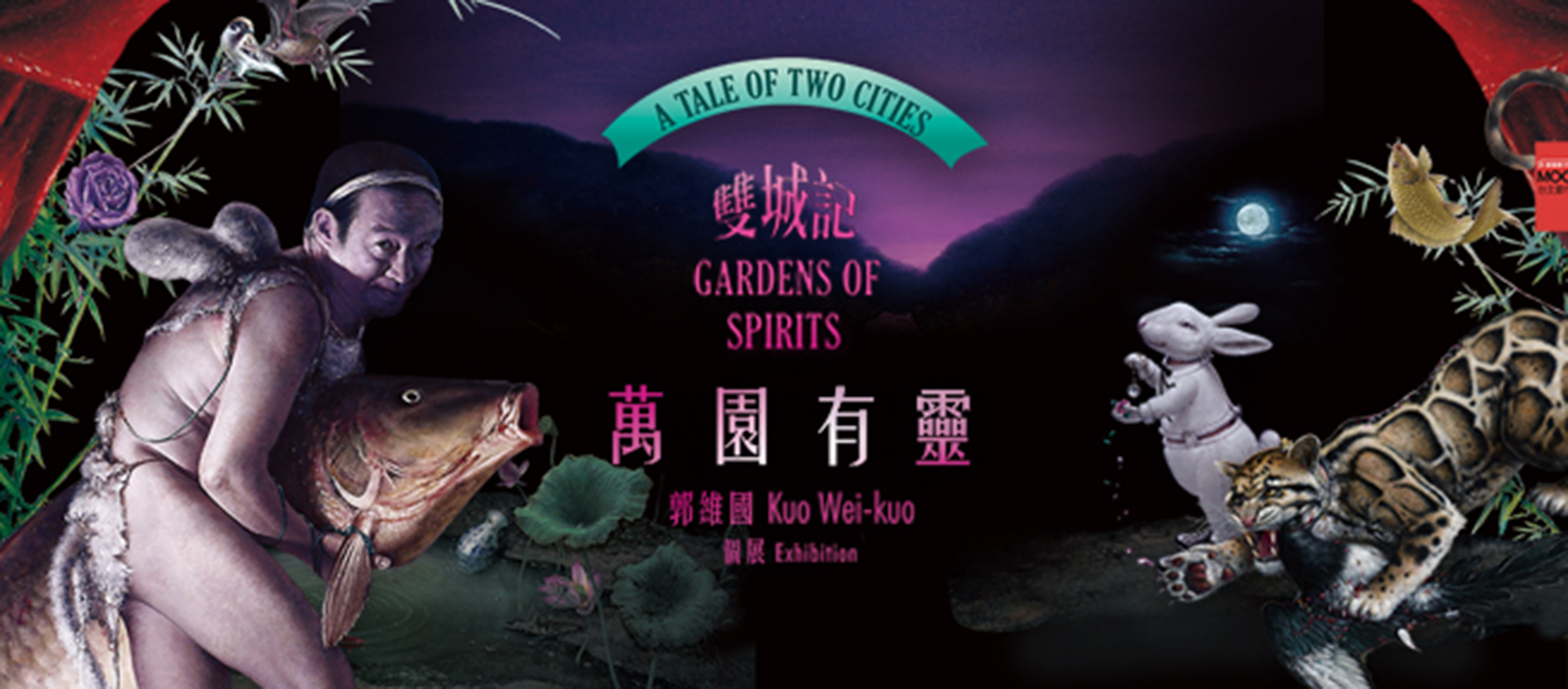

台北當代藝術館 官方網站 Museum of Contemporary Art, Taipei
Monday 星期一
10AM - 6PM



Monday 星期一
10AM - 6PM
EXHIBITIONS & EVENTS 展覽活動

2015 / 01 / 07 Wed.
2015 / 03 / 15 Sun.
10:00 - 18:00
每一個城市中,都存在著靈光閃爍的故事,關聯到一些曲徑通幽的歷史和人物。一座城市即是一本關於時間、記憶、個體與生命延展的百科全書。這之中記載著一些奇妙的事實,和超脫現實的無數幻想、悲歡離合、愛恨情仇。每一個人都代表一個故事,它存在自我的世界中,也在無形中成為現實世界裡的某個角色,生活在都市中,也彷彿是在一個沒有樂理可循的奏鳴曲中遊蕩。 本次個展,郭維國將連接各個展廳的紅磚走廊,改造成一個融合古典美學和宗教性格的純白空間,讓觀者從這個通道的幾個節點,進入藝術家以近年畫作和全新的立體作品,串聯而成的奇想空間與夢幻世界。這個白色通道,既是一種精神旅程,也是一條尋找靈光之路。人生的路程,即使只是驚鴻一瞥,每個人的一生都可以成為一個童話,一個開始追逐自我和不斷想像自我的歷程。在這個歷程之中,精靈相伴,穿園而行。 策展論述 「這是最好的時代,這是最壞的時代;這是智慧的年代,這是愚蠢的年代;這是信仰的時期,這是懷疑的時期;這是光明的季節,這是黑暗的季節;這是希望之春,這是絕望之冬;我們擁有一切,我們一無所有;我們正走向天堂,我們都在奔向與其相反的地方…」 -查理斯·狄更斯《雙城記》 狄更斯在《雙城記》中敘述了他所處的那個矛盾的、鮮活的時代。在那個時代中,人們遭遇著前所未有的困境,它既來自於它自身的歷史沿襲,也不斷的接受著當下不斷發生的改變。「雙城記」作為此次陸先銘和郭維國雙個展的歷史隱喻,所指涉的正是在今天我們所面對的現實以及存在的可能。 每一個人心中都會有一個理想的社會或者家園,這種理想往往是對一種積極模式的尋求。在此次展覽中,陸先銘和郭維國的共同展出,正是對人的生存語境和現實遭遇的探討,兩位藝術家從上世紀80年代始終從臺灣本土的現實社會所發生的變遷出發,以審視的態度將社會問題轉為藝術語言的表達動力。或者說,陸先銘和郭維國在通過藝術的方式對現實的回應過程中,都涉及到社會空間、歷史空間、文化空間對個體的擠壓,以及這種擠壓所導致的變異。 在藝術手法上,兩位藝術家的作品都具有極強的象徵性,對形象、空間、符號的錯置與混合,通過戲劇化和場景化的方式將現實中的事物進行再次編排,從而使得現實問題集中化,物與物之間構成了一種新的張力關係,這種關係既構成了一種藝術風格的獨特性,也將對現實問題的思考再次深入。 無論是陸先銘還是郭維國,此次展覽都試圖勾勒出一個關於臺灣社會發展的線索,在城市化和現代化的進程之中,臺灣本土所映射出的關於人的困境、生存的困境。他們都指向在現實之外的理想家園,關於這個時代的種種切片,人與社會的沉浮、個體與群體的失落和幻想,那些發生和正在發生的改變。 陸先銘和郭維國用這個展覽演繹了一個雙城記,這兩座個體之城相互重疊,它是彼此的矛盾,也是彼此的寄託。在臺北當代藝術館的建築之中,我們既能看到這座城市經歷的歷史,也能看到兩位藝術家心中的城池,他們都共同指向關於這個時代在這座城市中生活的人們,所遭遇的發生,那些無聲無息的浮城過影與萬園有靈。 There exists a spirit story in every city, linked with a path that connects history and characters. A city is an encyclopedia that covers time, memories, individuals and life. Inside it records some wonderful facts, and numerous other-worldly real fantasies, the vicissitudes of life, love, hatred, passion and animosities. Every person represents a story, existing in the world of egos, they become imperceptibly a real character, also seemingly as if wandering through a sonata that no musician can play. In this solo exhibition, Kuo Wei-kuo will transform all the red-brick corridors linking together the exhibition rooms into a pure white space mixing together classical and religious aesthetics, to allow viewers to enter into the illusionary world of artists from recent years and three-dimensional works of art. This white thoroughfare is both a kind of spiritual journey and a path searching for the divine. Even if the journey of life allows us but a fleeting glimpse, everyone’s life can become a fairytale, the beginning of a course in a search, and an unending imagining of the self. In the process, the spirit accompanies you as you travel through the exhibition. Curatorial Statement It was the best of times, it was the worst of times, it was the age of wisdom, it was the age of foolishness, it was the epoch of belief, it was the epoch of incredulity, it was the season of Light, it was the season of Darkness, it was the spring of hope, it was the winter of despair, we had everything before us, we had nothing before us, we were all going direct to Heaven, we were all going direct the other way… - A Tale of Two Cities, by Charles Dickens In A Tale of Two Cities, Dickens gave shape to that clashing, vibrant era in which he lived. It was an era when people encountered unprecedented dilemmas; the making of the era stemmed from its own historical lineage as well as the constant barrage of changes it weathered. As the historical metaphor for Lu Hsien-ming and Kuo Wei-kuo’s solo exhibitions, The Tale of Two Cities signifies both the reality we must confront and the possibilities of existence. There is an ideal homeland in everyone’s heart. Such idealism is often the embodiment of the search for proactivity. The two artists’ works here come together in this manner to explore the context of human life and the circumstances of reality. Starting from the massive social changes happening throughout the 1980s in Taiwan, the artists transform social issues into the impetus for artistic expression while striking a stance of inquisition. Or, we can say that in both Lu and Kuo’s artistic responses to the reality they must live in, they address the pressure forced upon the individual in the social space, the cultural space and the historical space. At the same time, they document the mutation caused by such pressure. In terms of artistic style, the works of both artists are extremely symbolic in nature; they displace and remix images, spaces and symbols, and reorganize mundane objects through theatricality in order to concentrate and distill real world issues, creating a whole new kind of tension among the everyday objects. Such tension not only contributes to the uniqueness of the artistic style but also further examines the real-world issue at hand. Both Lu Hsien-ming and Kuo Wei-kuo attempt to trace out the clues to the development of Taiwanese culture, the human and existential predicament on this tiny island under the advent of urban development and modernization. Both point to an ideal homeland outside of reality, where slices of this age mingle with the rise and fall of men and society, the disillusions and fantasies of the individual and the masses, and all that has changed and is still changing. Kuo and Lu performed a tale of two cities with their exhibitions; these cities of individuals overlap each other, embodying each other’s conflicts and hopes. In the physical architecture of MoCA Taipei, we can at once detect the history that our city weathered and the cities of the artists’ visions. For both artists, the cities of their heart refer to the people and happenings right here right now, all those silent glimpses of cities and gardens of spirit.
MORE
LESS
CLOSE
ADMISSION 門票
ADMISSION 門票
CLOSE
著作權聲明
台北當代藝術館尊重他人著作權,台北當代藝術館服務條款亦明定,網友使用台北當代藝術館服務不得侵害他人之著作權,因此,台北當代藝術館呼籲使用者同樣尊重他人之著作權。如果您認為台北當代藝術館網站中之任何網頁內容或網友使用台北當代藝術館服務已侵害您的著作權,建議您利用本處理辦法提出檢舉,台北當代藝術館客服中心將儘速為您處理:
若台北當代藝術館網站中之任何網頁內容或網友使用台北當代藝術館服務已侵害您的著作權,請您填寫:「 著作權侵權通知書」,且依該通知書所載提供下列資料及聲明,並以傳真的方式通知台北當代藝術館:
1、著作權人之簽名、或著作權人之代理人之簽名、相關權利證明文件及著作權之內容,例如:已發行書籍之封面及相關頁面、發表於網路中之網頁內容列印紙本及其網址。
2、侵害著作權之內容所在的網頁及網址。
3、您的聯絡地址、電話等資料。
4、書面聲明您確信該網頁內容的使用行為是未經過著作權人、其代理人或法律的授權。
5、書面聲明您於通知書所載相關資料均為真實,且您是著作權人或著作權人之代理人而為上開聲明。
若台北當代藝術館網站中之任何網頁內容或網友使用台北當代藝術館服務已侵害您的著作權,請您填寫:「 著作權侵權通知書」,且依該通知書所載提供下列資料及聲明,並以傳真的方式通知台北當代藝術館:
1、著作權人之簽名、或著作權人之代理人之簽名、相關權利證明文件及著作權之內容,例如:已發行書籍之封面及相關頁面、發表於網路中之網頁內容列印紙本及其網址。
2、侵害著作權之內容所在的網頁及網址。
3、您的聯絡地址、電話等資料。
4、書面聲明您確信該網頁內容的使用行為是未經過著作權人、其代理人或法律的授權。
5、書面聲明您於通知書所載相關資料均為真實,且您是著作權人或著作權人之代理人而為上開聲明。
隱私權保護政策
台北當代藝術館非常重視用戶的隱私權,因此制訂了隱私權保護政策。請你細讀以下有關隱私權保護政策的內容。
隱私權保護政策的適用範圍
1、隱私權保護政策內容,包括台北當代藝術館如何處理在用戶使用網站服務時收集到的身份識別資料,也包括台北當代藝術館如何處理在商業伙伴與台北當代藝術館合作時分享的任何身份識別資料。
2、隱私權保護政策不適用於台北當代藝術館以外的公司,也不適用於非台北當代藝術館所僱用或管理的人員。
3、台北當代藝術館在你註冊台北當代藝術館帳號、使用台北當代藝術館的產品或服務、瀏覽台北當代藝術館網頁、參加宣傳活動或贈獎遊戲時,台北當代藝術館會收集你的個人識別資料。台北當代藝術館也可以從商業夥伴處取得個人資料。
4、當你在台北當代藝術館註冊時,我們會問及你的姓名、電子郵件地址、出生日期、性別、職位、行業及個人興趣等資料。你在台北當代藝術館註冊成功,並登入使用我們的服務後,我們就會認識你。
5、台北當代藝術館也自動接收並紀錄你瀏覽器上的伺服器數值,包括互聯網協定位址 (IP Address) 、台北當代藝術館cookie中的資料及你要求取用的網頁紀錄。
6、台北當代藝術館會使用資料作以下用途:改進為你提供的廣告及網頁內容、完成你對某項產品的要求及通知你特別活動或新產品。
7、台北當代藝術館不會向任何人出售或出借你的個人識別資料。
8、在以下的情況下,台北當代藝術館會向政府機關、其他人士或公司提供你的個人識別資料:與其他人士或公司共用資料前取得你的同意。
9、需要與其他人士或公司共用你的資料,才能夠提供你要求的產品或服務。
10、向代表台北當代藝術館提供服務或產品的公司提供資料,以便向你提供產品或服務 (若我們沒有事先通知你,這些公司均無權使用我們提供的個人資料,作提供產品或服務以外的其他用途)。
11、應遵守法令或政府機關的要求。
12、我們發覺你在網站上的行為違反 台北當代藝術館服務條款或產品、服務的特定使用指南。
13、其他依「個人資料保護法」或政府法令應公開之資料。
14、為了保護使用者個人隱私, 我們無法為您查詢其他使用者的帳號資料,請您見諒!若您有相關法律上問題需查閱他人資料時,請務必向警政單位提出告訴,我們將全力配合警政單位調查並提供所有相關資料,以協助調查及破案!
15、 台北當代藝術館會到你的電腦設定並取用台北當代藝術館cookie。
16、台北當代藝術館容許在我們網頁上擺放廣告的廠商到你的電腦設定並取用cookie。其他公司將根據其自訂的隱私權保護政策,而並非本政策使用其cookie。其他廣告商或公司不能提取台北當代藝術館的cookie。
17、當台北當代藝術館進行與其產品及服務有關的工作時,會使用 web beacons 進入我們的網站網絡,提取cookie使用。
18、台北當代藝術館賦予你在任何時候修改個人台北當代藝術館帳號資料及偏好設定的權力,包括接受台北當代藝術館通知你特別活動或新產品的決定權。